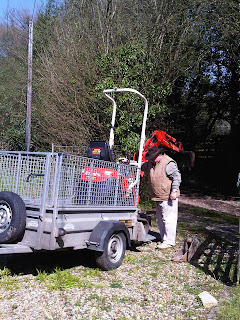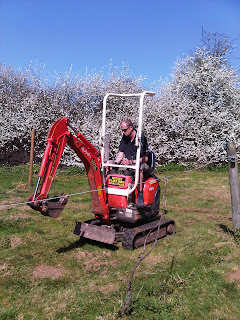
Yes, our Triomphe d'Alsace Rosé was finally bottled and released. It had been the last chance for our Triomphe grapes.

Another undrinkable wine and they would have been used henceforth for grape juice which is admittedly delicious. Encouraged and it has to be said bolstered with rather too much euphoria, we embarked on a programme of soil improvement and planting in the gaps where nothing has grown for many a year. We thought at first that we would just order a very few vines to see what might succeed but with the bit between our teeth ended up with a full scale experimental vineyard: 27 x Dornfelder, 15 x Frühburgunder, 25 x Pinot Noir, 27 x Regent, 27 x Rondo, 8 x Wrotham Pinot. These will be planted in a small plot at the top of the garden. In the middle plot are our disobliging Bacchus. This year, we are determined to spray them for the first time. It appeares Bacchus will not produce without treatments. We thought this was a bit of a swizz given that Bacchus is only a crossing - we might as well be growing Pinot Blanc or some such pure vinifera variety. Then after extensive enquiries we were informed that if we wanted something the equivalent of our Triomphe which didn't need any looking after, the only thing was Seyval Blanc. With a trip to Cologne in the offing we decided to visit the Research station at Geisenheim and see if they had come up with anything new for the job since Seyval Blanc was pioneered by Mr. Seyve and his son-in-law, Mr. Villard in 1919. What an admirable the Forschungsanstalt Geisenheim is! As well as industriously researching, crossing and hybridising all kinds of grapes it is a University as well.

It was here that Müller-Thurgau was first propagated and they have the original plant to prove it.

Here, what was called a 'Vorlesung' (lecture) was taking place:

Having requested a guided visit we were entrusted to Dip. Ing. Bettina Lindner,

the co-author of the Report on Geisenheim Grape Varieties and Clones (Geisenheimer Rebsorten und Klone, Geisenheimer Berichte 67).

She not only talked us through the various varieties fitting our needs but took us down to the cellars in order to taste the wines made from them.

This was an unimaginable advantage and half a dozen varieties we alighted on GM 8107-3,

a deliciously apply (Bettina preferred citrussy) wine from grapes descended from Ehrenbreitsteiner and FR 52-64 (meaning a grape cultivated by the Freiburg Institute in 1952). Ehrenbreitsteiner is itself a crossing of two generations of other crossings. As in any other kind of breeding the hope is that progress may be made over time. Bettina Lindner told us she had sold the GM 8107-3 to a French gentleman looking for varieties to plant in Brasil or some such humid part of the world and this person had decided the variety should have a proper name and chose 'Bettina'. We were pleased to follow his lead, so 'Bettina' it is.
We were also offered samples of Red varieties including Bolero which has become popular as a disease-resistant variety. The problem with the taste of Bolero was a hint of smoked ham in the background. Not unpleasant in itself but a little too original for its own good in our opinion. After signing a solemn document promising not to give anyone cuttings we departed with 30 'Bettina' vines in a plastic bag and made for Rebschule Martin in Gundheim (the German for vine nursery is rendered rather charmingly as Rebschule or literally 'Grape-School'). Gundheim is a bit further on than Gundersheim which we fortunately stumbled on by mistake. Fortunately because it is a remarkably beautiful village unlike any others we have seen in Germany. Not at all bijou or kitsch. No half-timbered houses or Gingerbread atmosphere. Here was an almost French mood with rendered buildings and a Burgundian kind of charm.

Turning down Rieslingstrasse in Gundheim we came across the Rebschule of the charming Herr Martin - it was just about now that we realised everyone we had met in the course of our investigations in Germany had been charming.

Herr Martin checked his stock from which we decided on 25 Solaris vines being hardy, fungus-resistant and early ripening. They grow it in Denmark so we think it may be suitable for a particularly ill-favoured corner of our little vineyard. Solaris has as its parents Merzling (which is Seyve-villard 5276 x (Riesling x Pinot Gris)) as mother vine with Gm 6493 (which is Zarya Severa x Muscat Ottonel) as the father. Back at the ranch and by now completely obsessed, we ordered 25 x Goldriesling and 25 x Johanniter from Rebschule Steinemann, also in Hessen. We had been warned against these varieties for growing in England but at under €2 each, we couldn't resist. We have enjoyed Goldriesling so much from Germany's most northerly vineyard in Meissen and Johanniter from The Netherlands that we are hopeful (delusional?) that we may get something in a hot year those climate change experts have been promising us.
The digging and planting is being done by Burt and Sean who sound like two characters from Sesame Street. When we saw how much effort was needed in our stony clay soil, we rang around and discovered a mechanical digger for hire just down the road.

Much better. We have left plenty of holes for other varieties, perhaps next year.

Eventually the idea is to decide on what does best on our plot and rip out the rest. Somehow we hope it will be 'Bettina' for the whites and perhaps Dornfelder for the reds.
 We were introduced to this wonderful white grape in a sparkling version from Umbria by the noted vinophile Charles Taylor who knows a thing or three. Immediately we recognised that with Spergola (a recent addition to SHoF - Slotovino Hall of Fame), here was a rival (we think an improvement) on Prosecco. There is also the still version which we haven't tried.
We were introduced to this wonderful white grape in a sparkling version from Umbria by the noted vinophile Charles Taylor who knows a thing or three. Immediately we recognised that with Spergola (a recent addition to SHoF - Slotovino Hall of Fame), here was a rival (we think an improvement) on Prosecco. There is also the still version which we haven't tried.